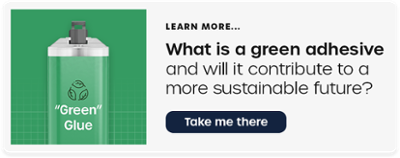The Future of Bonding; 5 Key Adhesive Trends to keep an eye on in 2024

As 2023 comes to a close, and the obligatory “What to expect in 2024” posts flood our feeds, we thought we would join in.
The world of adhesives is advancing quickly. Innovations, sustainability targets, and restrictions have all impacted the adhesive market in 2023.
Here at Forgeway, we’ve been manufacturing industrial adhesives for over 25 years. We’ve seen a lot of change over those years. From advancements in technologies to surprising (and innovative?) new applications.
2023 has been no different.
We expect more of the same in 2024. So, we are going to share what adhesive trends we expect to take place in 2024 in this article.
Here are the top five trends we recommend you keep an eye on in 2024.
1. The topic of sustainability isn’t going anywhere
The much-needed shift towards a greener future is reshaping industries all over the globe. The adhesive industry is no different. Industrial manufacturers often ask us how our adhesives can help them meet their sustainability products.
Often, the request is along the lines of introducing a ‘Green Adhesive‘ into their processes, or removing unnecessary wastage. Nonetheless, a sustainable future is inevitable. We all must play our part to make it a reality as soon as possible.
We expect the focus on sustainability to increase significantly in 2024.
With increasing plastic taxes in 2024 and widespread goals to reduce carbon output, industrial manufacturers are welcoming any help to meet targets and thresholds.
There are small but effective changes we can all make. From using adhesives with a lower carbon footprint to implementing less wasteful packaging options. The emphasis in 2024 will be to make those changes. We can all play our part in a more sustainable future.
And from a business-minded point of view, buyers are paying more attention to the sustainability of the companies they are buying from. We must stay on board the sustainability train. The future of the planet depends on it.
2. Recyclable and reversible bonding is gathering pace
Following a similar theme to the sustainability trend, we think recyclability is going to be a big theme in 2024. Reversible bonding will help manufacturers ensure their products are recyclable at the end of their life.
Reversibility was a big question in 2023. Manufacturers wanted to have the option to ‘undo’ the bond if required. The manufacturers could undo the bond by exposing it to heat, UV, or certain chemicals.
Whilst adhesive manufacturers have been focussing on making their adhesives as durable and permanent as possible, the desire for removable options has presented an interesting challenge.

The thought of deliberately making an adhesive bond reversible doesn’t seem sensible. Especially to us as adhesive manufacturers.
However, the logic of a reversible makes sense. Let’s think about it.
Mechanical fasteners are one of the most popular and common joining methods worldwide. And they are mostly reversible easily, (rivets are not so easy to remove).
The reversibility is one of the reasons people use mechanical fastening for joining despite the obvious drawbacks. So to put that advantage into the adhesive’s toolbox makes complete sense.
That’s why we expect to see the reversibility trend continue in 2024. Not only does it make sense from a manufacturing perspective, but it also has environmental benefits too. Undoing a bond will help with recycling materials and reducing the amount of waste going to landfill.
3. High-performance applications are putting adhesive capabilities to the test
We have worked on some very interesting applications this year. Whilst we cannot discuss them for legal reasons, they have all been focussing on pushing the limits of adhesive capabilities.
Extremely high-temperature resistance, high-pressure resistance, and high-strength requirements are just some examples of what customers are asking us to explore.
But as more companies are becoming aware of the benefits of using adhesives, these high-performance applications are going to become even more widespread.
One such application we anticipate increasing in 2024 is battery bonding. The exponential increase in battery-electric vehicles has demanded innovation when it comes to bonding.
It’s not just for EVs though. Combustion engines and hybrid cars have more electrical components now than ever before. Batteries are in pretty much every vehicle.
So we expect these trends to continue throughout 2024. Companies will be pushing innovation in their designs. They will want to maximise the possibilities that adhesives present to them.

4. Are Adhesives becoming the joining method of choice?
As we alluded to above, confidence in adhesives is increasing. But it still isn’t the most trusted joining method. Manufacturers and companies prefer to use a method they know and trust; like mechanical fasteners or welding.
Whilst these methods of joining are reliable (in most cases), they still have drawbacks that can make them less desirable than using adhesive bonding.
The main benefit is focussed on lightweighting. Composite materials are replacing metals in more vehicles (as JLR are constantly demonstrating) to help facilitate lightweighting. You can’t weld composite materials. Mechanical fasteners can damage them.
Adhesives are the best method of joining composite materials.

The upsurge in composite material use isn’t slowing any time soon. Lightweighting is becoming a major focus for industrial manufacturers. So adhesive use will obviously increase with that.
But will adhesives overtake welding or mechanical fastening as the joining method of choice? We don’t expect it to.
That doesn’t mean we don’t expect to see more and more interesting applications as industrial manufacturers look to switch away from traditional joining methods.
We’ve just witnessed the increase in confidence in adhesive bonding which has led to some fascinating projects. We expect that to rise in 2024.
5. Health and safety concerns on the rise
2023 saw the implementation of restrictions around isocyanates which affected some polyurethane adhesives. It’s worth noting these restrictions weren’t a surprise from nowhere (they were originally discussed in 2019).
There aren’t any other restrictions (we are aware of) coming into force in 2024 that will affect industrial adhesive use. However, 2023 also saw new welding fume regulations. Other joining methods are also facing the consequences of increased health and safety concerns.
And whilst there may not necessarily be restrictions put into place, we still expect operatives and employees to pay more attention to the products they are using in 2024.
Industrial manufacturers need to consider the health and safety concerns that some industrial adhesives could present. This will help them stay ahead of the curve before restrictions cause them to change a few years down the line.
What you can do to keep ahead of the competition in 2024
Now that you have read a few of the things we expect to see more of in 2024, it’s time to put the words into action. But what does that look like for you?
It’s a question we’ve been asked in recent weeks as companies prepare for the new year.
As we have been manufacturing industrial adhesives for over 25 years, we have seen plenty of change in that time. Here at Forgeway, we understand the need to keep up with this change. Otherwise, you risk getting stuck in the past (pun intended.
The drive towards a sustainable future has gathered pace in the past few years. It isn’t slowing down.
That’s why you need to make sure you keep up with the latest innovations and developments in adhesive bonding. It will help ensure you have a wealth of knowledge, you don’t lose your competitive advantage and you stay ahead of the competition.
2024 isn’t promised to be an easy ride. Make sure you pay attention to what is happening in the indsutry around you. We know that your job is more than just maximising adhesive bonding. Much more.
We also know that adhesives and bonding could help you overcome the inevitable challenges you’re going to face. They could well be the answer to increasing your profitability in 2024.
Thomas is the Content Manager here at Forgeway. Thomas' job is to translate the technical jargon from the ivory tower of academia into easy-to-read content that everyone can understand. Forgeway's mission is to answer every question our customers and prospective clients ask, or are apprehensive to ask.
Topics:





